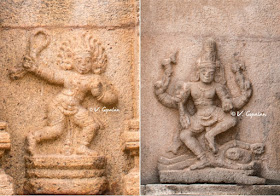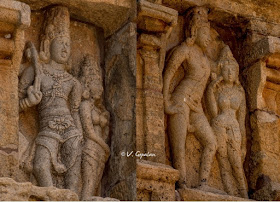
There is a wonderful temple complex in Kudumiyan Malai. The oldest part of the Kudumiyanmalai Temple complex is the rock cut cave shrine called Melakkoil. In the same complex The Kuduminatha temple came a few centuries after the cave temple, sometime in the 10th century. Built by the Cholas, it was renovated by the Pandyas in the 13th century and by the Vijayanagar Kings in the 15th. During every renovation these kings have added some outstanding sculptures to this temple.

If this temple is in some form today it is because of The Archaeological Survey of India (ASI). This temple complex was almost ruined few years back and it is the ASI which has painstakingly restored this great temple to it's original glory. Today this temple is in reasonably good condition and it is under the care of ASI. With all their limitations I should say that ASI is maintaining this temple very well.

Thousand pillared mandapam at the entrance has sculptures of Hanumanji, Sugreevan and Vaali. Since this is the latest addition to the complex the sculptures have not been exposed to the onslaught of Muslim Invasion and hence are in very good condition.

The next hall is called Vasantha Mandapam which houses sculptures of Narasimha, Rati and Manmathan, Ugra thandavam of Shiva, Subramanya on peacock, Agora Veerabhadrar.
Above the Melakkoil is a rare bas-relief of Siva and Parvati on rishaba vahanam, flanked by the 63 Nayanmars.


Forfurther details one can always Google!



I have taken all these pictures in this temple in its natural background. In order to bring out the details of each sculpture I have cut out the sculptures from its natural cluttered background and posted them in this post!

















































